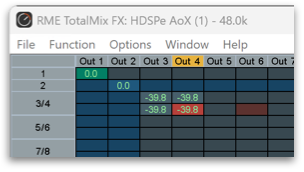The Matrix
The mixer window of TotalMix looks and operates similar to mixing desks, as it is based on a conventional stereo design. The matrix display presents a different method of assigning and routing channels, based on a single channel or monaural design. The matrix view of the HDSPe AoX-D has the look and works like a conventional patchbay, adding functionality way beyond comparable hardware and software solutions. While most patchbays will allow you to connect inputs to outputs with just the original level (1:1, or 0 dB, as known from mechanical patchbays), TotalMix allows you to use a freely definable gain value per crosspoint.
Matrix and TotalMix are different ways of displaying the same processes. Because of this both views are always fully synchronized. Each change in one view is immediately reflected in the other view as well.
Elements of the Matrix View
The visual design of the Matrix is based on the architecture of the HDSPe AoX-D system:

-
Horizontal labels. All hardware outputs
-
Vertical labels. All hardware inputs. Below are all playback channels.
-
Green 0.0 dB field. Standard 1:1 routing
-
Dark grey field with number. Shows the current gain value as dB
-
Blue field. This routing is muted
-
Red field. Phase 180° (inverted)
-
Dark grey field. No routing.
To maintain overview when the window size has been reduced, the labels are floating. They won’t leave the visible area when scrolling.
How to use the matrix
Using the Matrix is a breeze. It is very easy to identify the current crosspoint, because the outer labels light up in orange according to the mouse position.
-
If input 1 is to be routed to output 1, use the mouse and click one time on crosspoint In 1 / Out 1 with held down Ctrl key. Two green 0.0 dB field pop in, another click removes them.
-
To change the gain (equals the use of a different fader position, see simultaneous display of the mixer view), drag the mouse up or down, starting from the gain field. The value within the field changes accordingly. The corresponding fader in the mixer view is moving simultaneously, in case the currently modified routing is visible.
-
On the right side is the Control Strip from the mixer window, adapted to the Matrix. The button for the temporary fader group is missing as well as all View options, as they do not make sense here. Instead the button Mono Mode lets you decide whether all the actions performed in the Matrix are valid for two channels or just one.
The Matrix not always replaces the mixer view, but it significantly enhances the routing capabilities and - more important - is a brilliant way to get a fast overview of all active routings. It shows you in a glance what is going on. And since the Matrix operates monaural, it is very easy to set up specific routings with specific gains.